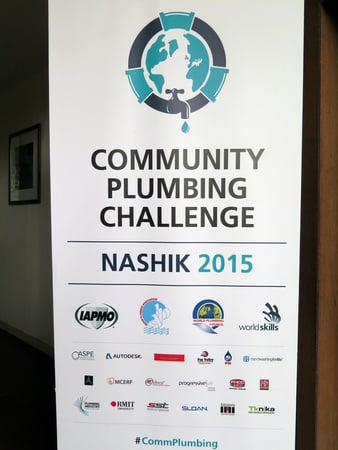The 2015 Community Plumbing Challenge – “stopping people getting sick”
The 2015 Community Plumbing Challenge has just been completed in Nashik, India. The works built, process of design, construction and school involvement provide a model of how communities, skilled people and resources can be combined to achieve both immediate and longer term health benefits for 400 children.
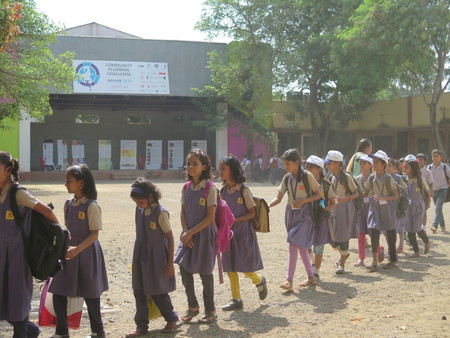
Background
2015 marks 30 years since the simple phrase “stopping people getting sick” first guided the work of HH.
In 2014 the Water Innovation Challenge (WIC) was held in Singapore. It was championed by the WorldSkills Foundation, IAPMO and the World Plumbing Council. HH supported this event by providing the tasks to be undertaken of the Challenge.
Two teams competed in the event that had an obvious WorldSkills competition heritage, where trades compete in a skills ‘Olympics’. The two key differences between the parent event and it’s 2014 offspring were that the teams were multi skilled – included in each team were plumbers, an engineer/designer, and graphic designer, and the tasks set for the Challenge were taken from the real world projects of HH (one in Nepal and one in Bangladesh).
The work was carried out in a public place within an advanced technical college in Singapore over 4 days. Whilst HH harvested ideas and the idea of multi skill teams was born, no community was directly improved during the event nor was neither team exposed to the communities from which the Challenge tasks were generated.
A tough, constructive review of the Challenge by WSF Chair Tjerk Dusseldorp and staff, on site directly after the Singapore event, produced a firm commitment to repeat the event in 2015 and some fundamental changes.
Some of the important changes were;
- the name of the event should emphasise the link to real world, community based problems related to plumbing,
- if possible, the number of teams competing should be increased,
- the Challenge should have a community ‘client’ with real needs,
- the Challenge task should continue to require the work of multi skilled teams,
- the design brief, issued well before the Challenge, should be more concise and clearly define the tasks to be achieved,
- the briefing documents should set out materials available, time frames and costs,
- there should be more links with the local community during the on-site Challenge.
The 2015 Community Plumbing Challenge
The 2015 Community Plumbing Challenge in Nashik, India has just ended and with the help and support of the School 125 community and all the supporting organisations and their staff. The event was considered a great success by all those participating.
What was achieved?
- from having only 4 taps available for hand washing and a limited water supply with poor pressure, the school now has 25 working taps and hand wash drainage, 2 taps are now located in toilet areas, where none previously existed, and there is increased water tank storage capacity and better water pressure,
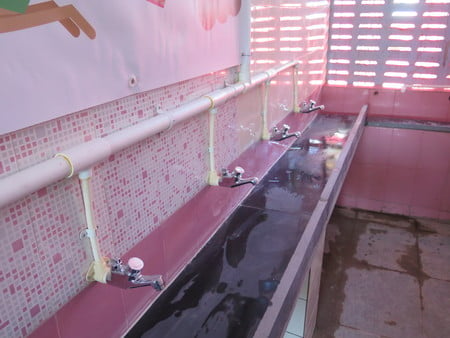
One or the two new hand washing troughs and taps. The hand washing water drained from this trough flushes the adjoining toilet urinal drains.
- from no urinal flushing being available in 2 toilet areas, resulting in a foul smell, the urinals are now flushed by re-used hand wash water drained into the urinal trough and additional push button flush taps and spreaders to wash urinal walls,
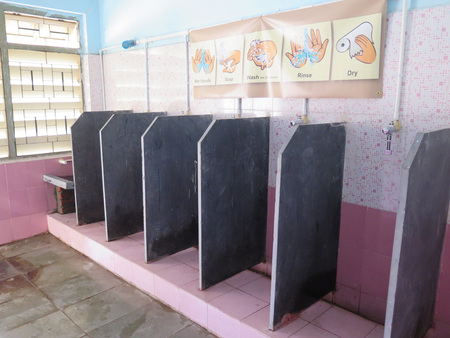
New urinal flushing and hand wash point at the end of the room. Also note new fixed louvres (left of picture) ventilate and light the room.
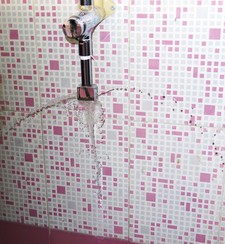
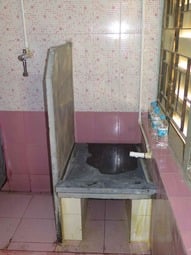
New flush taps (press start and spring loaded with set water flow) and water spreader for wall washing (left) and hand wash point (right)
- shutters on the toilet walls that had to be kept shut for privacy have been replaced with permanently fixed louvres giving light and constant air flow through the areas,
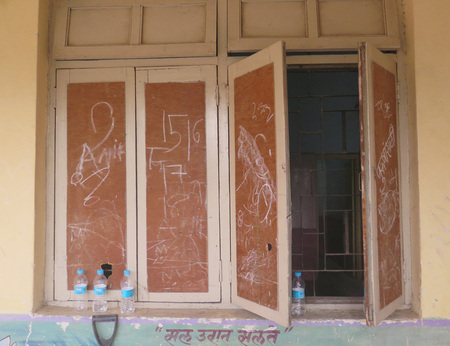
The old shutters had to be kept closed for privacy and allowed no ventilation or light to the area.
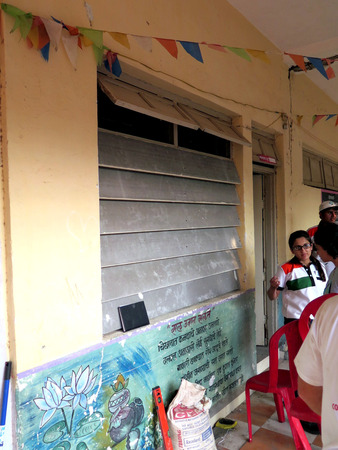
The installed louvres allow airflow, light and privacy
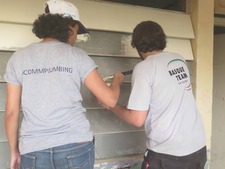
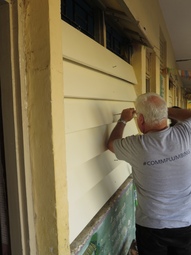
Painting the louvres inside and out to reflect more light (left) and the final fixing (right).
- the 4 teams came to the event with 4 considered designs, the ideas within all the design work were combined and reworked to ensure the needs of the school were met – this meant teams had to work collaboratively each contributing to the whole,
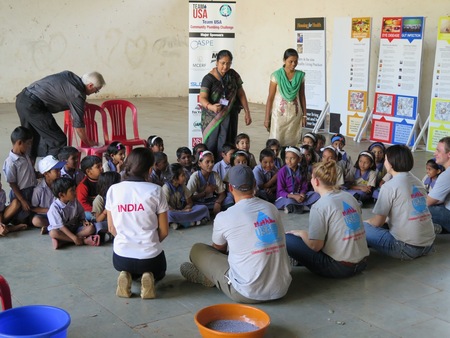
A member of Team India helps Team USA present a lesson with a health message to a class of children.
- water meters were installed on the various branch lines of piping to assess water use, tap performance, design performance and maintenance needs and frequency – this information will be collected by school students and be invaluable if the program is to be expanded across India,
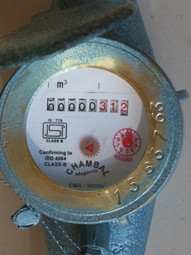
Typical water meter. 7 have been installed to monitor the performance of the newly upgraded facilities.
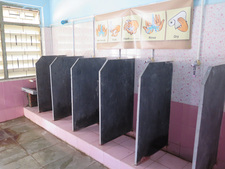
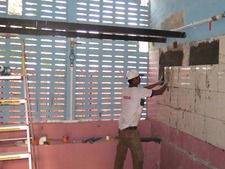
Look carefully and find the 2 water meters (top left in the left hand picture) and centre of the breeze block wall in the right hand picture.
- classes by each of the 4 teams on a health aspect of plumbing, sanitation were delivered to school classes whilst the building works proceeded – each team included games, songs and props of all sorts to engage the children,
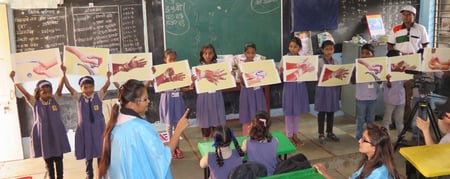
Team India works with a class to get the correct sequence of hand washing having just completed a demonstration of hand washing and the important benefits
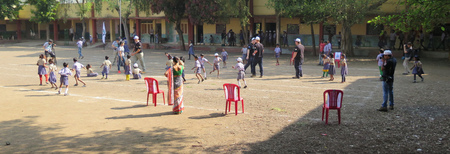
Team Australia plays ‘Hand Wash’ cricket with 3 target chairs to be hit by the student ‘batters’. The toilet chair, the hand wash chair and last the meal chair were the targets.
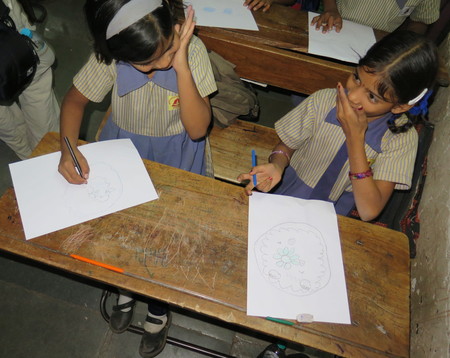
Team Basque started the class with the kids drawing germs ….hand washing followed.
Team USA used a magic dust mixed with soil to hide a pencil. The children had to use their hands to find the pencil. Their hand were checked and shown under black light to be ‘dirty with germs’. Hand washing followed and after a second black light inspection showing clean hands …the pencil was given to each child as a reward.
- workshops by each of the 4 teams on a trade skill related to the water or sanitation works being completed in the school, were also delivered to classes – each team included demonstrations in bricklaying, pipe threading or making water filters,
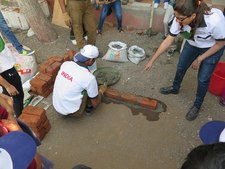
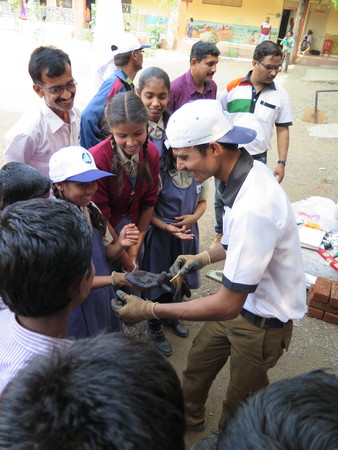
Team India showed brick laying skills (top) and then put the gloves on children and ask them to help laying bricks.
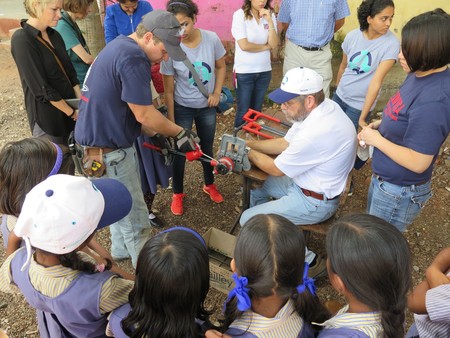
Team USA showed how to thread metal plumbing pipe and invited the class to help.
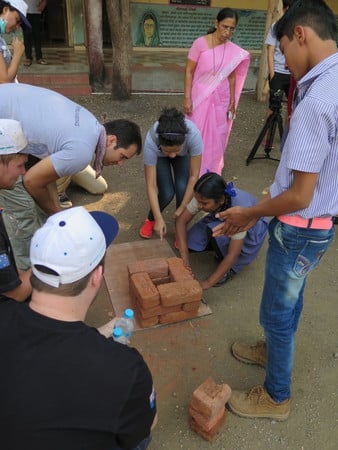
Team Australia showed how brick coursing can give strength and then invited the children to test their skills.
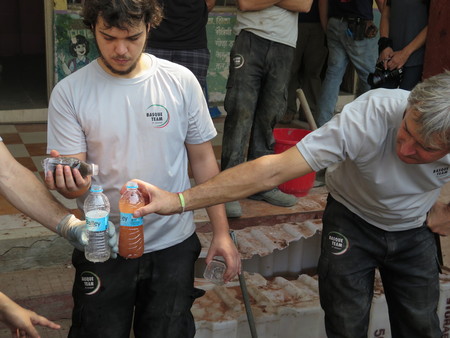
Team Basque shows the effectiveness of a simple water filter and then helps all the class to make their own.
- all the works were recorded by the Digital Hub that was set up near the school, this digital recording of all the construction details and specification of parts will be a teaching tool to allow the repeating of theses types of works in other Indian Schools,
- a movie by Singaporean school movie makers was made to document all aspect of the event.
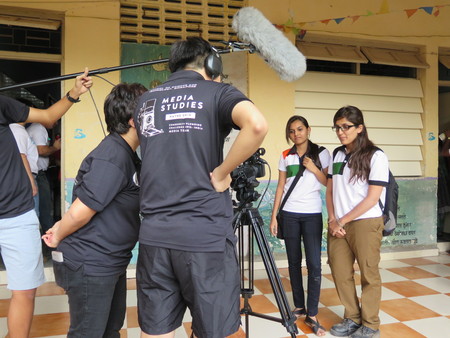
The movie making team conducts an interview with Team India members.
To achieve all the above took a year of organising, months of thinking and preparation by the Teams and their support staff and 4 days on the site at Nashik.
At the start of the Challenge there were four Teams, from four parts of the world, with four ideas to be the one Challenge winner. Within a day of the work beginning it was clear to us all that the school community had to be the one winner of the Challenge and that would take the collaboration of all the Teams, there supporters and all the organisations behind the Challenge.
There were direct gains in the construction of health infrastructure and concurrently, the engagement of the local school community in both the building process, learning something about the value of trade skills and the essential health messages linked to the works.
Thanks to all involved and may the next 2016 Challenge learn lessons from this great event.
